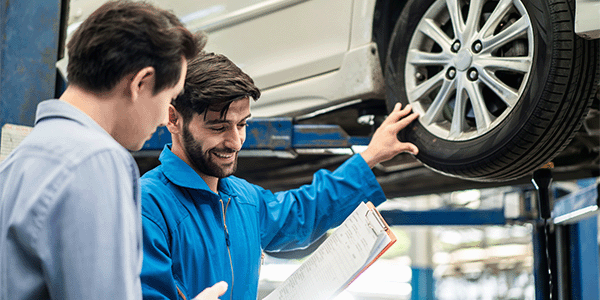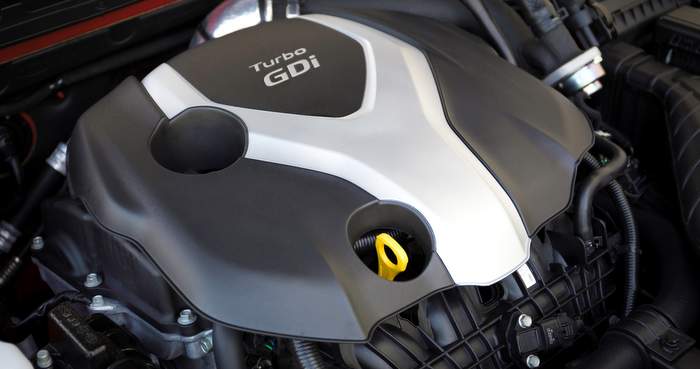 While some vehicle problems will motivate the customer to make an appointment, an equal amount of Kia repair opportunities will be discovered as the vehicle is being serviced. If you’re not already doing so, always encourage your customers to keep their vehicle maintenance up to date. And, just as important, let them know your techs are trained and equipped to handle any maintenance requirements.
While some vehicle problems will motivate the customer to make an appointment, an equal amount of Kia repair opportunities will be discovered as the vehicle is being serviced. If you’re not already doing so, always encourage your customers to keep their vehicle maintenance up to date. And, just as important, let them know your techs are trained and equipped to handle any maintenance requirements.
I’ve been surprised more than once by a long-time customer who said they were not aware that we could handle exhaust replacement, or that we could do an oil change service while they wait. Never assume that the customer knows all the services you offer, or how you can accommodate their vehicle repair needs.
UNDERCAR MAINTENANCE
From a safety standpoint, it could be argued that the steering and suspension system on any car is the most critical. That’s why it’s so important that every Kia that goes on the lift gets a basic safety check. A good visual inspection takes only a couple of minutes but will provide huge benefits to both your shop and the customer. You also have the satisfaction of knowing you solved the problem and put the customer in a safer car.
With MacPherson strut being the system of choice on Kia’s line of cars, a simple shake, rock and roll will pick up problems that may go unnoticed by the driver. Grab the wheel at the nine and three o’clock positions and shake it from side-to-side, feeling for looseness in the steering system.
If you feel some play, have an assistant look for the movement, concentrating on the inner and outer tie rod ends, side movement of the ball joint, and control arm bushing and wheel bearing play. Move your hands to the 12 and six o’clock positions and continue rocking the wheel. Here you’ll pick up play in the strut shaft or mounting, ball joint and control arm bushing. Spin the wheel to check for noises and smooth rotation. Any dragging is probably a result of a brake problem and should be investigated.
If you find play at the inner tie rod, confirm that it’s the joint and not the rack bushing that is worn. If the rack boot allows it, squeeze the boot to feel that the joint is the problem and the rack isn’t loose and moving in the housing.
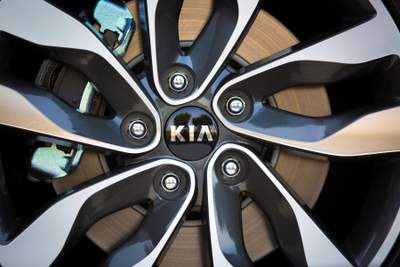 This will also give you an indication if the rack boot needs to be replaced. It’s always a good practice to replace the boot, but you may find it’s easier to obtain a tie rod end rather than a direct-fit boot. Some of the universals fit well, but if you have to order the tie rod end, add the boot kit to the order.
This will also give you an indication if the rack boot needs to be replaced. It’s always a good practice to replace the boot, but you may find it’s easier to obtain a tie rod end rather than a direct-fit boot. Some of the universals fit well, but if you have to order the tie rod end, add the boot kit to the order.
With outer joints, make note of the length of the rod before the end is removed to get the toe in the ballpark on reassembly; many techs simply count the turns when the rod is removed, but a measurement from the center of the joint to a known point is a good backup. Either way, be sure the toe is within specs before the car is returned to the customer. If the play is a result of a worn ball joint, most Kia models will require that you change the lower control arm, as the joints are not replaceable.
The most common suspension complaint you’ll hear from the owner will be noise related, often described as a creaking or rubbing sound as well as the familiar knocking complaint. While a road test on a road in poor condition will confirm the complaint, we have better luck with rocking the car side by side while checking for looseness that will lead to the knocking sound. Most of these noises will be traced to the anti-sway bar mounting and links. Rocking the car will unload and load these components, usually resulting in a diagnosis with which you can be confident.
If play in the wheel bearing is noticed, it should be taken care of whether or not it’s noisy. Check the torque on the axle nut; if it’s loose, you’ll have to make a judgment call. Is it the result of a previous repair, or is the bearing or hub worn? If the play is excessive and the re-torque has no effect, be sure a hub is available before the car is disabled on the lift. While it’s not a common problem on Kias, it’s not unheard of for the hub to show wear on the inner race area, especially in light of the amount of trouble-free miles these cars deliver.
PAY ATTENTION TO THE BRAKES
The first step in any job is to establish why the customer thinks the brakes need to be serviced. The most common complaint we’ll hear is a heavy metal-to-metal grinding sound when braking, which indicates that one or more of the pads are worn to the backing plate. But it’s the more obscure problems that require some specific questions. For me, the most important question is, “Will the tech experience the problem on a road test?” If the answer is “no,” get as much detail as you can about when the problem occurs.
An occasional long pedal could be a master cylinder bleeding down, which usually happens in a stop-and-go or a downhill situation where the brakes are being used. Or, it could also be the fluid heating after a run on the interstate, making the pedal fade as a result of the brakes binding. Knowing when the problem happens will not only save you some time, but it will certainly help you avoid a misdiagnosis.
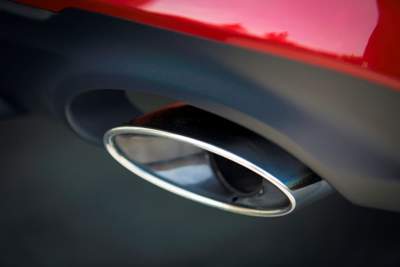 If you’re looking at a grinding problem, the next step is to check for uneven wear. If one wheel is showing more brake wear than the other on that axle, it’s time to do some investigating.
If you’re looking at a grinding problem, the next step is to check for uneven wear. If one wheel is showing more brake wear than the other on that axle, it’s time to do some investigating.
Before you jump to the conclusion that you have a frozen caliper, take a couple of minutes to confirm the diagnosis and look at the rest of the system so you can give the customer an accurate estimate, and get all the parts you need in one call.
The first step is to confirm what’s causing the brake to drag. While our first thought might be the caliper, there was no customer-reported odor or vibration after an extended interstate run that would point to a locked-up caliper. And, we know the rotor will be showing signs of overheating as a result of that wheel dragging and having to do more than its share of the work.
Push the caliper pistons back but, before you do, attach your bleed bottle and open the bleeders so you’re not pushing the most contaminated fluid back up through the dirt-sensitive ABS unit. You’re going to be bleeding and flushing the system anyway as part of the service, so you might as well get rid of that used up fluid from the calipers right away.
With the bleeders open, the pistons should return with little effort; if not, consider a pair of replacement calipers. If the problem doesn’t appear to be the calipers, check for the pads sticking in the caliper brackets, and don’t overlook the slider pins as a source of binding. Keep in mind how important smooth mechanical operation is to the braking system. We have more than 1,000 psi applying the brakes, and we’re relying only on caliper piston seals and mechanical condition to release them.
Remember, everything from a long pedal stroke to a good pedal that just doesn’t stop well, can be traced back to the same mechanical issues we’re looking at while diagnosing the uneven wear.
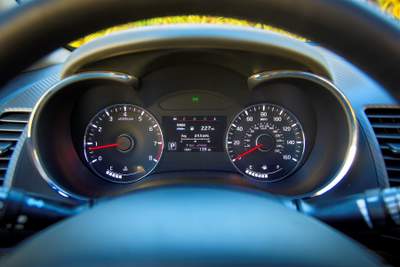 With the calipers off the brackets, continue to look for issues that could be causing the uneven wear problem. If the caliper pistons move freely and the boots are in good shape, turn your attention to the sliders and pad movement. If you find nothing dragging on the worn side, double-check the other wheels for binding that’s preventing that caliper from doing its fair share of the work. Usually pad wear patterns will indicate this kind of problem.
With the calipers off the brackets, continue to look for issues that could be causing the uneven wear problem. If the caliper pistons move freely and the boots are in good shape, turn your attention to the sliders and pad movement. If you find nothing dragging on the worn side, double-check the other wheels for binding that’s preventing that caliper from doing its fair share of the work. Usually pad wear patterns will indicate this kind of problem.
We can prevent these problems by using good work habits when we’re performing any brake service. When you’re replacing friction material, take the time to clean and protect the surfaces of the caliper bracket where the pads contact. Be sure to remove the anti-rattle hardware to get rid of any rust that may build up under these parts. Remove, clean and lubricate the sliders, ensuring a good, solid brake pedal, as well as an ABS system that will function as designed.
A solid buildup of rust and corrosion on the non-friction area of the rotor is common, and for the cost involved it doesn’t make sense to risk a noise or vibration comeback.
I’m sure you’re going to inspect the rear brakes before the estimate is written. Again, be sure everything is operating freely and don’t overlook the rear wheel cylinders for smooth operation, just like on the front. If the shoes are good, there’s no reason to disassemble them, but push on the pistons to be sure the cylinders aren’t frozen. If the shoes are worn, be sure to free up and lube the contact areas of the backing plate, as well as all of the adjustment and handbrake hardware.
ABS/ESC Enhancements
We’ve talked about the mechanical aspects of the undercar service, but Kia certainly hasn’t been standing still when it comes to the electronic aspect of undercar improvements. ABS has been in use for years, along with ESC (electronic stability control). This system looks at wheel speed, brake and steering inputs, as well as vehicle yaw and lateral acceleration, to assist the driver.
A more recent change is the use of electric power steering assist, which uses an electric power steering (EPS) module controlled by various sensors (steering angle sensor, torque sensor, fail-safe relay, etc.) located inside the steering column. This system can provide a more precise and timely control than the formerly used hydraulic systems. The EPS steering column and EPS unit assembly must not be disassembled for inspection. If service is required, replacement will be necessary.
Check Service Recommendations
In this day of extended intervals, it pays to check Kia’s service recommendations, as they will vary depending on engine size. As an example, in our area where many of our customers have a 50-mile or better commute to work, the economical Soul is a popular model. On the 1600cc-equipped models, spark plugs get replaced every 30,000 miles, while the 2.0-L version has no mention of plugs in the schedule (we would still recommend replacement at 90,000 miles). In recent years, Kia has made the move away from timing belts to chains, but there are still many of these cars on the road where Kia recommends that the belt be replaced at the 90,000-mile mark.
UNDERHOOD MAINTENANCE
The most common underhood maintenance service will be timing belt replacement. Usually performed as a recommended service at 90,000 miles, this is a good opportunity to suggest additional services that are due at the same mileage. At a minimum, any accessory drive belts should be replaced, and it’s a good idea to suggest water pump replacement at the same time. Even if the pump looks good, there’s a good chance it won’t last another 90,000 miles. It’s not a hard sell once the customer is made aware of the labor costs and inconvenience involved to replace the pump at a later date.
The same applies to the camshaft and crank seals, so any sign of leakage should motivate replacement. If you’re using the common 30,000-, 60,000- and 90,000-mile service intervals, it’s also time to recommend the relatively extensive 90,000-mile service. Doing the timing belt and 90,000-mile service on the same visit can be expensive, but many customers will prefer having both done on the same visit for time and labor reasons.
Some of the familiar customer complaints involve no power, rough run, misfires and hard-start issues. If the check engine lamp is lit, you need to determine if it’s the result of the problem that concerns the customer, or whether it’s been on for months with no obvious problem.
Kias are also susceptible to the relatively common cam and crank sensor codes. Often presented as a stalling condition, they’ll usually start right back up and can be driven into the bay. In this case, we just change the sensor if a sensor code is present. On the crank sensors, it’s common for the harness to be damaged by the timing belt if the harness is not routed properly. There are also numerous reports of the cam sensor being damaged during water pump replacement.
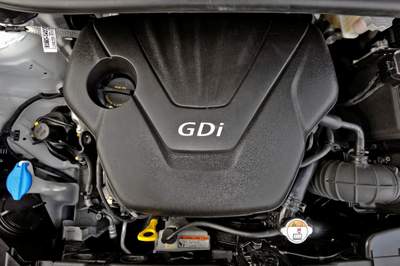 On the four-cylinder cars, there are reports of crank sensor failures after broken belts are replaced. Debris from the old belt not being thoroughly removed can be the culprit, so be sure there is nothing jammed between the sensor and reluctor. If the sensor is removed, be sure it’s installed facing the proper direction (facing the reluctor), as it’s easy to install it “backward.”
On the four-cylinder cars, there are reports of crank sensor failures after broken belts are replaced. Debris from the old belt not being thoroughly removed can be the culprit, so be sure there is nothing jammed between the sensor and reluctor. If the sensor is removed, be sure it’s installed facing the proper direction (facing the reluctor), as it’s easy to install it “backward.”
We talked earlier about how important it is for both the shop and customer to keep up on required vehicle maintenance. With that said, the most important service we perform is the basic oil change service. Often performed by the least experienced tech, it’s important that this person is well trained on what should be inspected as the service is performed, to keep an eye out for other necessary maintenance. For example, rather than merely topping up low fluid, the tech should find out what caused the fluid to go low.
Likewise, the water pump should be checked for leaks at the same time that the drive belts are inspected. Any indication of leakage should be noted or pointed out to a more experienced tech so the decision can be made if immediate service is required, or the service can wait until a future visit. This isn’t upselling, but rather an opportunity to provide a higher level of service your customers expect, as they’ve chosen to have an oil service performed by a full service shop, rather than at a quick oil change place.
Kia has moved toward direct fuel injection with its GDI system. This system creates few problems from the maintenance perspective, but be aware it’s there and follow the proper safety procedures if you’re working on the fuel system. These systems, with their high-pressure mechanical pumps, make a great deal of fuel pressure that has to be relieved before the system is opened.
With the GDI system, Kia also recommends that a valve cleaning fuel additive be added every 7,500 miles in conjunction with the oil change. I would recommend that it should be added at least every other oil change, and, as expected, Kia recommends its product.
The later-model Kias are equipped with the now common electronic throttles. While very reliable, there will be a time when cleaning will become necessary. Most of us are aware that we can no longer flood the housing with cleaner and risk damage to the sensitive electronics in the unit. Using the cleaner sparingly, we spray the cleaner on a rag and wipe the throttle blade and housing. On more stubborn units, a stiff nylon brush will usually do the trick.
It’s important that your shop makes the investment necessary to be able to diagnose these systems. For starters, it will require a scanner with enhanced capabilities. While the factory tools would be ideal, there are other options available that will give you access to a variety of vehicles. With these tools becoming more affordable, there’s just no reason for your shop not to have one.











